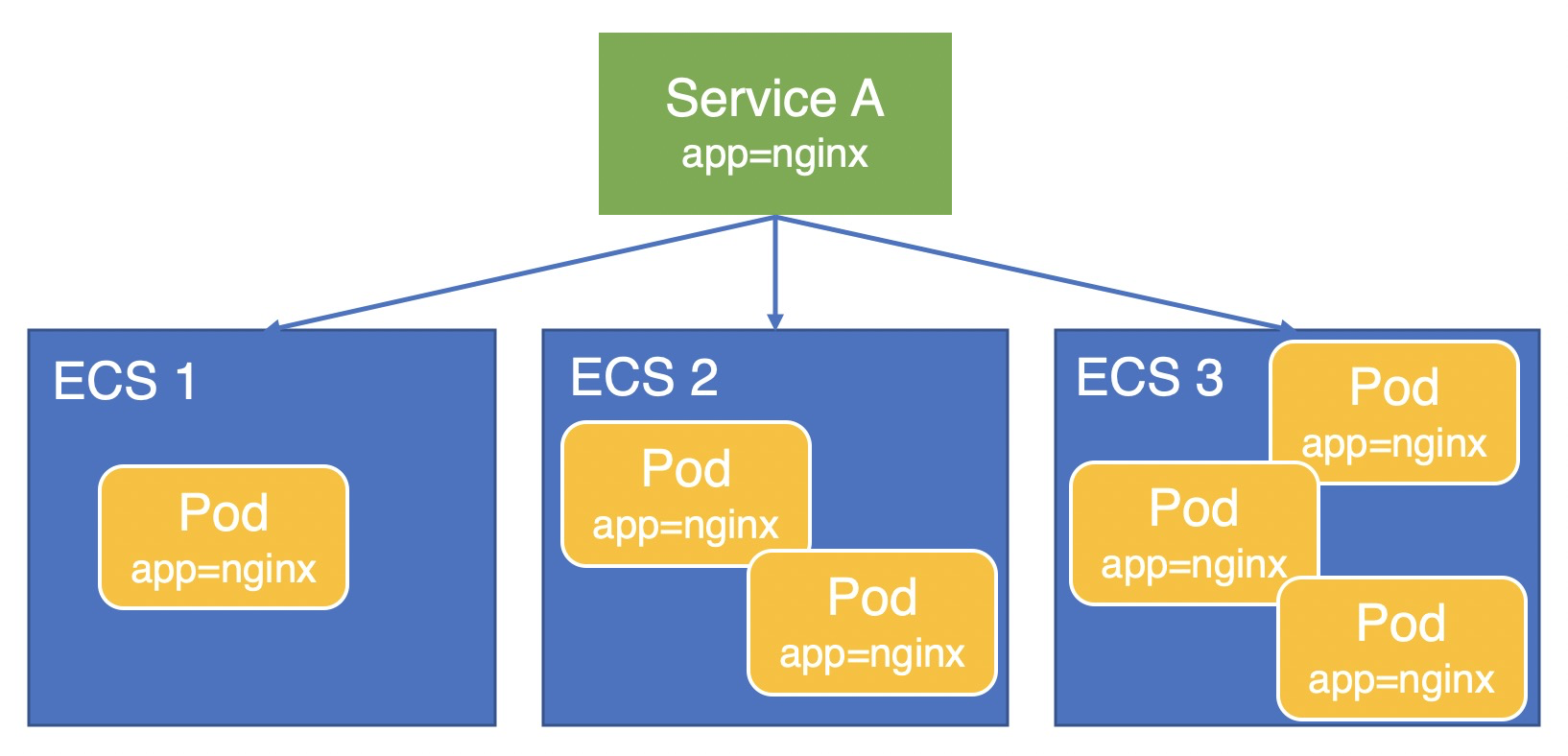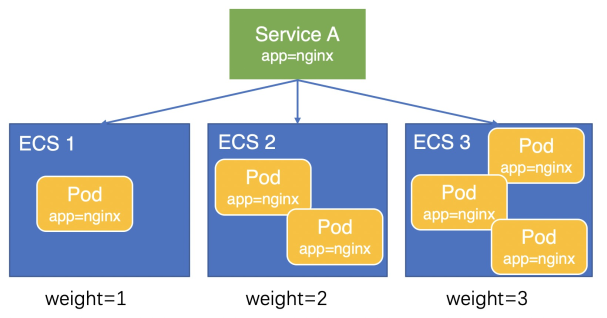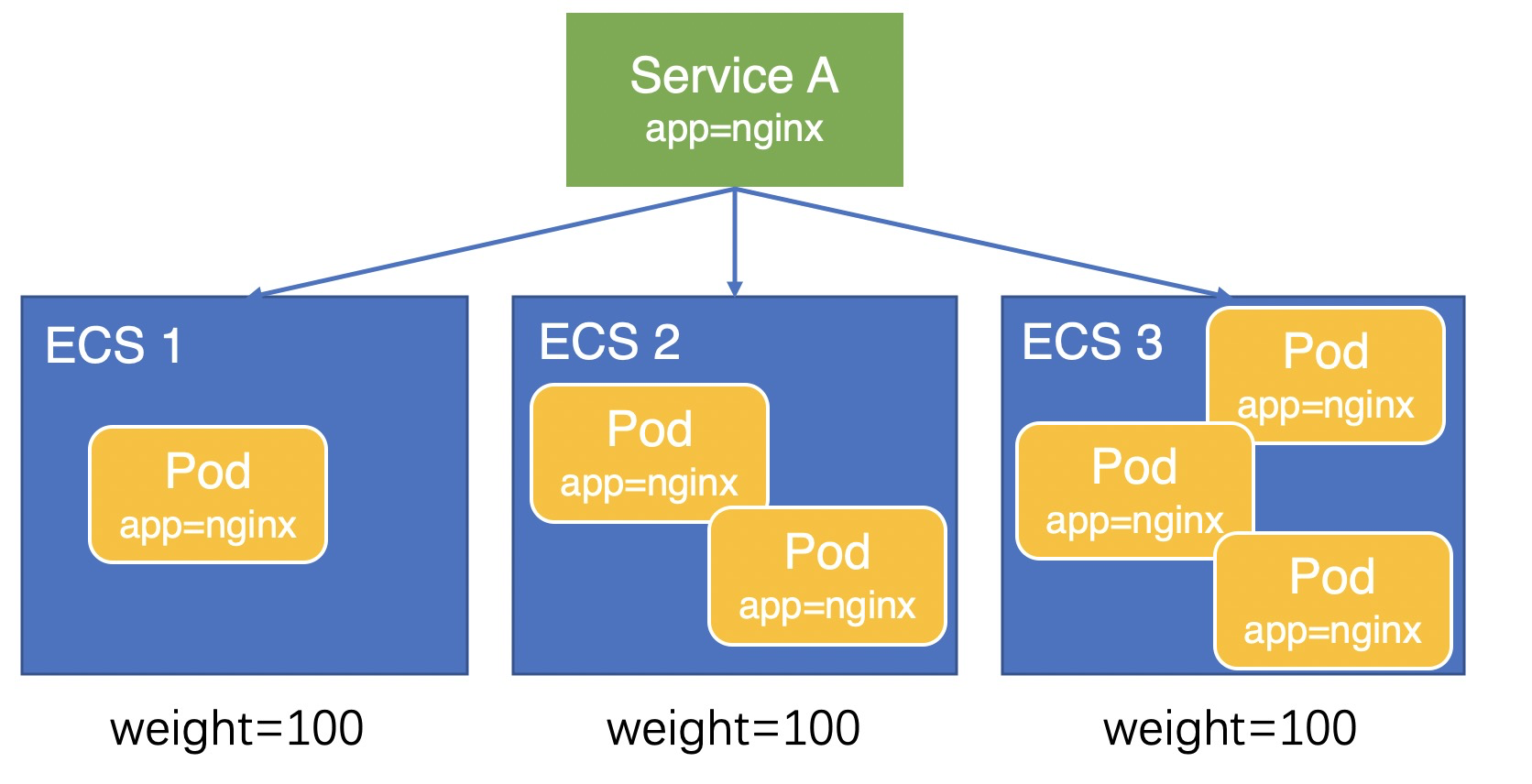本文匯總了使用Container ServiceACK Service時的一些常見問題。包括但不限於為什麼叢集內無法訪問SLB IP、為什麼複用已有SLB沒有生效、CCM升級失敗如何處理等問題的解決方案。
索引
SLB相關
使用已有SLB常見問題
其他
SLB相關
ACK叢集中SLB執行個體的具體用途
如果建立Kubernetes叢集時安裝了Nginx Ingress組件,那麼叢集會預設自動建立兩個SLB執行個體。
兩個SLB執行個體的用途說明如下:
APIServer SLB:該SLB執行個體為API Server的訪問入口,訪問叢集均需要與該SLB執行個體通訊。監聽連接埠為6443,監聽協議為TCP。後端節點為APIServer Pod或者Master ECS。
Nginx Ingress Controller SLB:該SLB執行個體與kube-system命名空間下的
nginx-ingress-controller服務關聯,虛擬伺服器組會動態綁定Nginx Ingress Controller Pod,實現對外部請求的負載平衡和路由轉寄。監聽連接埠為80和443,監聽協議為TCP。
建立Service時,Local和Cluster兩種外部流量策略如何選擇?
不同網路外掛程式,Local和Cluster兩種外部流量策略的功能不同。關於Local和Cluster兩種外部流量策略的詳細區別,請參見外部流量策略Local和Cluster介紹。
為什麼看不到Service與LoadBalancer同步過程的事件Event資訊?
如果執行命令kubectl -n {your-namespace} describe svc {your-svc-name}後看不到Event資訊的話,請確認您的CCM組件版本。
SLB建立一直處於Pending狀態如何處理?
執行命令
kubectl -n {your-namespace} describe svc {your-svc-name}查看事件資訊。處理事件中的報錯資訊。關於事件中不同報錯資訊的處理方式,請參見報錯事件及對應處理方式。
如果看不到報錯資訊,請參見為什麼看不到Service與LoadBalancer同步過程的事件Event資訊?。
SLB虛擬伺服器組未更新如何處理?
執行命令
kubectl -n {your-namespace} describe svc {your-svc-name}查看事件資訊。處理事件中的報錯資訊。關於事件中不同報錯資訊的處理方式,請參見報錯事件及對應處理方式。
如果看不到報錯資訊,請參見為什麼看不到Service與LoadBalancer同步過程的事件Event資訊?。
Service註解不生效如何處理?
按照以下步驟查看報錯資訊。
執行命令
kubectl -n {your-namespace} describe svc {your-svc-name}查看事件資訊。處理事件中的報錯資訊。關於事件中不同報錯資訊的處理方式,請參見報錯事件及對應處理方式。
如果沒有報錯資訊,分以下三種情境解決:
確認您的CCM版本是否符合對應註解的版本要求。關於註解和CCM的版本對應關係,請參見通過Annotation配置傳統型負載平衡CLB。
登入Container Service管理主控台,在服務頁面,單擊目標服務的服務名稱,確認服務Service中是否有對應的註解。如果沒有對應的註解,配置註解資訊。
關於如何配置註解,請參見通過Annotation配置傳統型負載平衡CLB。
關於如何查看服務列表,請參見Service快速入門。
確認註解資訊是否有誤。
為何SLB的配置被修改?
CCM使用聲明式API,會在一定條件下根據Service的配置自動更新SLB配置。您自行在SLB控制台上修改的配置均存在被覆蓋的風險。建議您通過註解的方式配置SLB。關於註解配置方式的更多資訊,請參見通過Annotation配置傳統型負載平衡CLB。
請勿在SLB控制台上手動修改Kubernetes建立並維護的SLB的任何配置,否則有配置丟失的風險,造成Service不可訪問。
為什麼叢集內無法訪問SLB IP?
情境一:設定SLB IP為私網地址,並且沒有通過Service方式建立SLB,那麼SLB後端Pod和訪問SLB Pod將在同一個節點,導致在叢集內訪問SLB IP失敗。
對於四層負載平衡服務,目前不支援負載平衡後端ECS執行個體直接為用戶端提供服務的同時,又作為負載平衡的後端伺服器。因此在叢集內訪問SLB IP會失敗。您可以通過以下方式解決該問題,從而避免訪問端和目的端在同一個節點。
將SLB IP修改為公網地址。
使用Service的方式建立SLB,同時設定外部流量策略為Cluster,這種情況下kube-proxy會劫持叢集內訪問SLB流量,繞過SLB本身限制。
情境二:使用Service發布服務時,設定了外部流量策略為Local,導致在叢集內訪問SLB IP失敗。
關於該問題的詳細原因和解決方案,請參見如何解決Kubernetes叢集中訪問LoadBalancer暴露出去的SLB地址不通?。
如何解決Kubernetes叢集中訪問LoadBalancer暴露出去的SLB地址不通?
問題描述
在Kubernetes叢集中,有部分節點能夠訪問叢集暴露出去的Local類型的SLB,但是也有部分節點不能訪問,且Ingress出現該問題較多。
問題原因
SLB設定了externalTrafficPolicy: Local類型,這種類型的SLB地址只有在Node中部署了對應的後端Pod,才能被訪問。因為SLB的地址是叢集外使用,如果叢集的節點和Pod不能直接存取,請求不會發送到SLB,會被當作Service的擴充IP地址,被kube-proxy的iptables或ipvs轉寄。
如果剛好叢集節點或者Pod所在的節點上沒有相應的後端服務Pod,就會發生網路不通的問題,而如果有相應的後端服務Pod,是可以正常訪問的。相關問題的更多資訊請參見kube-proxy將external-lb的地址添加到節點本地iptables規則。
解決方案
可以參見以下方法解決問題,推薦您使用第一種方法:
在Kubernetes叢集內通過ClusterIP或者服務名訪問內部服務。其中Ingress的服務名為:
nginx-ingress-lb.kube-system。將LoadBalancer的Service中的externalTrafficPolicy修改為Cluster。這種方式雖然可以確保流量能夠被轉寄到所有節點上的Pod,但會導致源IP地址丟失,因為叢集會執行SNAT(源網路位址轉譯)。這意味著後端應用無法擷取到用戶端的真實IP地址。Ingress的服務修改命令如下:
kubectl edit svc nginx-ingress-lb -n kube-system若是Terway的ENI或者ENI多IP的叢集,將LoadBalancer的Service中的externalTrafficPolicy修改為Cluster,並且添加ENI直通的Annotation,例如
annotation: service.beta.kubernetes.io/backend-type:"eni",具體格式如下,可以保留源IP,並且在叢集內訪問也沒有問題。詳細資料,請參見通過Annotation配置傳統型負載平衡CLB。apiVersion: v1 kind: Service metadata: annotations: service.beta.kubernetes.io/backend-type: eni labels: app: nginx-ingress-lb name: nginx-ingress-lb namespace: kube-system spec: externalTrafficPolicy: Cluster
什麼情況下會自動刪除SLB?
自動刪除SLB的策略取決於SLB是否由CCM自動建立。刪除策略如下表所示。
Service操作 | CCM自動建立的SLB | 複用的已有SLB |
刪除Service | 刪除SLB | 保留SLB |
修改LoadBalancer型Service為其他類型 | 刪除SLB | 保留SLB |
刪除Service是否會刪除SLB?
如果是複用已有SLB(Service中有service.beta.kubernetes.io/alibaba-cloud-loadbalancer-id: {your-slb-id}註解),刪除Service時不會刪除SLB;否則刪除Service時會刪除對應的SLB。
如果您更改Service類型(例如從LoadBalancer改為NodePort)也會刪除對應的CCM自動建立的SLB。
誤刪除SLB怎麼辦?
情境一:誤刪除API Server SLB如何處理?
無法恢複,您需要重建叢集。具體操作,請參見建立ACK Pro版叢集。
情境二:誤刪除Ingress SLB如何處理?
按照以下步驟重新建立SLB。
登入Container Service管理主控台,在左側導覽列選擇叢集。
在叢集列表頁面,單擊目的地組群名稱,然後在左側導覽列,選擇。
在服務頁面頂部的命名空間下拉式清單中,單擊kube-system,然後在服務列表中,找到目標服務nginx-ingress-lb,然後單擊目標服務。
如果沒有nginx-ingress-lb,請在當前頁面右上方單擊使用YAML建立資源,使用以下模板建立名為nginx-ingress-lb的Service。
apiVersion: v1 kind: Service metadata: labels: app: nginx-ingress-lb name: nginx-ingress-lb namespace: kube-system spec: externalTrafficPolicy: Local ports: - name: http port: 80 protocol: TCP targetPort: 80 - name: https port: 443 protocol: TCP targetPort: 443 selector: app: ingress-nginx type: LoadBalancer在目標服務的操作列,單擊YAML編輯,移除status內容後,然後單擊更新以讓CCM重新構建SLB。
情境三:誤刪除業務相關的SLB如何處理?
如果不需要SLB對應的Service,刪除Service。
如果對應的Service還需要使用,解決方案如下。
登入Container Service管理主控台,在左側導覽列選擇叢集。
在叢集列表頁面,單擊目的地組群名稱,然後在左側導覽列,選擇。
在服務頁面頂部的命名空間下拉框中,單擊所有命名空間,然後在服務列表中,找到業務Service。
在目標服務的操作列,單擊YAML編輯,移除status內容後,然後單擊更新以讓CCM重新構建SLB。
舊版本CCM如何支援SLB重新命名?
Cloud Controller Manager組件V1.9.3.10後續版本建立的SLB支援自動打TAG從而可以重新命名,而V1.9.3.10及之前的版本,您需要手動給該SLB打上一個特定的TAG從而支援SLB重新命名。
只有Cloud Controller Manager組件V1.9.3.10及之前版本建立的SLB才需要手動打TAG的方式來支援重新命名。
Service類型為LoadBalancer。
登入到Kubernetes叢集Master節點,請參見擷取叢集KubeConfig並通過kubectl工具串連叢集。
執行
kubectl get svc -n ${namespace} ${service}命令,查看該Service類型及IP。 說明
說明您需要將namespace與service替換為所選叢集的命名空間及服務名稱。
執行以下命令,產生該SLB所需要的Tag。
kubectl get svc -n ${namespace} ${service} -o jsonpath="{.metadata.uid}"|awk -F "-" '{print "kubernetes.do.not.delete: "substr("a"$1$2$3$4$5,1,32)}'
登入負載平衡控制台根據步驟2中所擷取的IP,在其所在的地區搜尋到該SLB。
根據步驟3產生的Key值和Value值(分別對應上圖的1和2),為該SLB打上一個Tag。具體操作,請參見管理標籤。
Local模式下如何自動化佈建Node權重?
本文以業務Pod(app=nginx)部署在三台ECS上,通過Service A對外提供服務為例,說明在Local模式下Node權重的計算方式。

V1.9.3.276-g372aa98-aliyun及之後版本
權重計算方式因為計算精度問題,Pod間還會存在輕微的負載不均。在V1.9.3.276-g372aa98-aliyun及之後版本,CCM將Node上部署的Pod數量設定為Node權重,如下圖所示,三台ECS的權重分別為1、2、3,流量會按照1:2:3的比例分配給三台ECS,Pod負載會更加均衡。
計算公式如下所示:

V1.9.3.164-g2105d2e-aliyun之後及V1.9.3.276-g372aa98-aliyun之前版本
V1.9.3.164-g2105d2e-aliyun之前版本
如何查詢叢集中所有SLB的IP、名稱及類型?
執行如下命令,擷取所有命名空間中每個LoadBalancer類型服務的名稱、IP地址和地址類型資訊。
kubectl get services -A -ojson | jq '.items[] | select(.spec.type == "LoadBalancer") | {name: .metadata.name, namespace: .metadata.namespace, ip: .status.loadBalancer.ingress[0].ip, lb_type: .metadata.annotations."service.beta.kubernetes.io/alibaba-cloud-loadbalancer-address-type"}'預期輸出如下:
{ "name": "test", "namespace": "default", "ip": "192.168.*.*", "lb_type": "intranet" } { "name": "nginx-ingress-lb", "namespace": "kube-system", "ip": "47.97.*.*", "lb_type": "null" }
LoadBalancer類型的Service更替後端時,如何確保LB能夠優雅中斷已有串連?
您可以通過Annotation service.beta.kubernetes.io/alibaba-cloud-loadbalancer-connection-drain和service.beta.kubernetes.io/alibaba-cloud-loadbalancer-connection-drain-timeout配置優雅中斷。從Service移除後端後,LB依然會在drain-timeout期間內保持存量串連的處理。詳細資料,請參見為監聽設定串連優雅中斷。
使用已有SLB常見問題
為什麼複用已有SLB沒有生效?
排查CCM版本,低於v1.9.3.105-gfd4e547-aliyun的CCM版本不支援複用。關於如何查看及升級CCM版本的操作,請參見升級CCM組件。
確認複用的SLB是否為叢集建立的,不支援複用叢集建立的SLB。
確認SLB是否為API Server的SLB,不支援複用API Server的SLB。
如果是私網SLB,請確認SLB是否和叢集在同一個VPC中,不支援跨VPC複用SLB。
為什麼複用已有SLB時沒有配置監聽?
確認是否在註解中配置了service.beta.kubernetes.io/alibaba-cloud-loadbalancer-force-override-listeners為"true"。如果沒有配置,則不會自動建立監聽。
複用已有的負載平衡預設不會覆蓋已有的監聽,有以下兩點原因:
如果已有負載平衡的監聽上綁定了業務,強制覆蓋可能會引發業務中斷。
由於CCM目前支援的後端配置有限,無法處理一些複雜配置。如有複雜的後端配置需求,可以在不覆蓋監聽的情況下,通過控制台自行配置監聽。
考慮到以上兩種情況,不建議您強制覆蓋監聽。如果已有負載平衡的監聽連接埠不再使用,則可以強制覆蓋。
其他
CCM升級失敗如何處理?
關於CCM組件升級失敗的解決方案,請參見Cloud Controller Manager(CCM)組件升級檢查失敗。
Service報錯資訊及對應處理方式
不同報錯資訊的解決方案如下表所示。
報錯資訊 | 說明及解決方案 |
| 指CLB的後端伺服器配額不足。 解決方案:您可以採取以下方式,最佳化配額消耗。
|
| 共用型CLB不支援ENI。 解決方案:如果CLB後端使用的是ENI,您需要選擇效能保障型CLB執行個體。在Service中添加註解 重要 添加註解需要注意是否符合CCM的版本要求。關於註解和CCM的版本對應關係,請參見通過Annotation配置傳統型負載平衡CLB。 |
| CLB無後端伺服器,請確認Service是否已關聯Pod且Pod正常運行。 |
| 無法根據Service關聯CLB。 解決方案:登入負載平衡管理主控台,根據Service的
|
| 帳號欠費。 |
| 賬戶餘額不足。 |
| CLB OpenAPI限流。 解決方案:
|
| 無法刪除虛擬伺服器組關聯的監聽。 解決方案:
|
| 複用內網CLB時,該CLB和叢集不在同一個VPC內。 解決方案:請確保您的CLB和叢集在同一個VPC內。 |
| 虛擬交換器不足。 解決方案:通過 |
| ENI模式不支援String類型的 解決方案:將Service YAML中的 |
| 低版本CCM預設建立共用型CLB,但該類型CLB已停止售賣。 解決方案:升級CCM組件。 |
| CLB資源群組一旦建立後不支援修改。 解決方案:移除Service中的註解 |
| 無法在VPC內找到指定的ENI IP。 解決方案:確認Service中是否配置了註解 |
| CLB計費類型不支援從隨用隨付轉為按規格收費。 解決方案:
|
| 複用了CCM建立的CLB。 解決方案:
|
| CLB的類型一旦建立後不可更改,建立Service後更改了CLB的類型會導致該報錯。 解決方案:刪除重建Service。 |
| Service已經綁定一個CLB,不能再綁定另一個CLB。 解決方案:不支援通過更改 |
當Service類型為NodePort時,如何為Service配置監聽?
CCM僅支援為LoadBalancer的Service配置監聽。您需要將Service類型從NodePort修改為LoadBalancer。
如何訪問NodePort類型的Service?
如果在叢集內(叢集節點內)訪問,您可以使用ClusterIP+Port,或者節點IP+Service中NodePort連接埠訪問Service。預設的NodePort連接埠會大於30000。
如果在叢集外(叢集節點外)訪問,您可以使用節點IP+Service中NodePort連接埠訪問Service。預設的NodePort連接埠會大於30000。
如果在VPC外部(其他VPC或者公網)訪問,您需要發布LoadBalancer類型的Service,然後通過Service的外部端點訪問Service。
說明如果您的Service設定了外部流量轉寄策略為本地,請確保被訪問的節點上存在Service後端Pod。關於更多外部流量策略,請參見外部流量策略Local和Cluster介紹。
如何正確配置NodePort範圍?
在Kubernetes中,APIServer提供了ServiceNodePortRange參數(命令列參數 --service-node-port-range),該參數是用於限制NodePort或LoadBalancer類型的Service在節點上所監聽的NodePort連接埠範圍,該參數預設值為30000~32767。在ACK Pro叢集中,您可以通過自訂Pro叢集的管控面參數修改該連接埠範圍。具體操作,請參見自訂ACK Pro叢集的管控面參數。
您在修改NodePort連接埠範圍時必須十分謹慎。務必保證NodePort連接埠範圍與叢集節點上Linux核心提供的
net.ipv4.ip_local_port_range參數中的連接埠範圍不衝突。該核心參數ip_local_port_range控制了Linux系統上任意應用程式可以使用的本地連接埠號碼範圍。ip_local_port_range的預設值為32768~60999。您所建立的ACK叢集在預設配置情況下,ServiceNodePortRange參數和
ip_local_port_range參數不會產生衝突。如果您此前為了提升連接埠數量限制調整了這兩個參數中任意一個,導致兩者範圍出現重合,則可能會產生節點上的偶髮網絡異常,嚴重時會導致業務健全狀態檢查失敗、叢集節點離線等。建議您恢複預設值或同時調整兩個連接埠範圍到完全不重合。調整連接埠範圍後,叢集中可能存在部分NodePort或LoadBalancer類型的Service仍在使用
ip_local_port_range參數連接埠範圍內的連接埠作為NodePort。此時您需要對這部分Service進行重新設定以避免衝突,可通過kubectl edit <service-name>的方式直接將spec.ports.nodePort欄位的值更改為未被佔用的NodePort。


